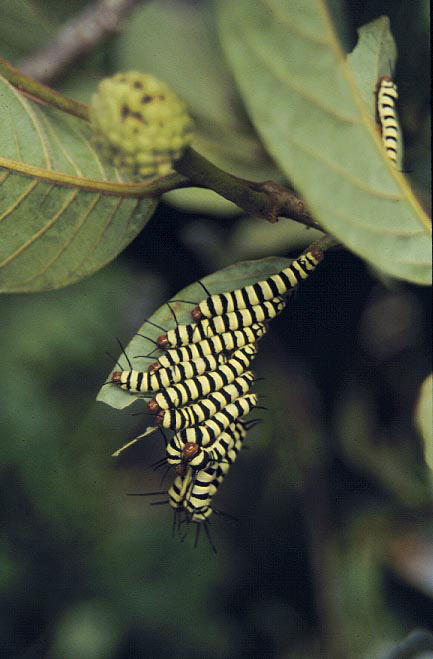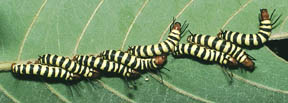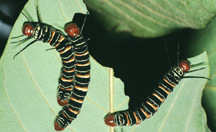Western Carolina University, Cullowhee, NC 28723 USA
http://www.wcu.edu/as/biology/costa/Costa.html

| . |
| James
T. Costa, Department of Biology Western Carolina University, Cullowhee, NC 28723 USA http://www.wcu.edu/as/biology/costa/Costa.html |
 |
This large Neotropical silkmoth is the only species in the genus Arsenura that exhibits sociality. Other Arsenura are solitary and cryptic, but A. armida has adopted an aposematic and gregarious lifeyle. It may be the only social representative of the subfamily Arsenurinae which occurs from tropical Mexico to northern Argentina and contains approximately 57 spp., very few of which are known from the early stages (Lemaire, 1980; Hogue, 1993).
Arsenura armida occurs from tropical Mexico to Bolivia and southeastern Brazil. In the tropical dry forest of Pacific Mexico and Central America, its caterpillars are found on Guazuma ulmifolia (Sterculiaceae), Rollinia membranacea (Annonaceae), and Bombacopsis quinatum (Bombacaceae) (Janzen and Hallwachs, 2002). Larvae emerge shortly after the rainy season in May, after passing the long dry season as a solitary and dormant pupa in a chamber excavated 2-10 cm below the soil surface. Part of the first generation enters a dormant pupal stage and part ecloses about 35-55 days after pupation, to create a second generation in November-December. All of the second generation pupae become dormant until the following start of the rainy season.
The
young larvae are brightly aposematically ringed yellow and black with
red
heads, and remain together diurnally feeding side by side in large
masses
on the leaves. Costa, Fitzgerald, and Janzen (2001) studied this
species in Santa Rosa National Park, Costa Rica, and showed that the
larvae
use a trail pheromone to maintain group cohesion.  Larval
trail-following can be elicited by surface cuticular material collected
by wiping from the venter and dorsum of the abdomen of A. armida
caterpillars, as well as crude extracts of homogenated somatic
tissue.
The long-lived trail marker appears to be a component of the cuticle
passively
deposited from the posterio-ventral region of the abdomen as larvae
travel
over the host plant.
Larval
trail-following can be elicited by surface cuticular material collected
by wiping from the venter and dorsum of the abdomen of A. armida
caterpillars, as well as crude extracts of homogenated somatic
tissue.
The long-lived trail marker appears to be a component of the cuticle
passively
deposited from the posterio-ventral region of the abdomen as larvae
travel
over the host plant.
In the fourth instar, A. armida larvae dramatically change their foraging strategy, switching from nomadic to central place foraging. Costa, Gotzek, and Janzen (in review) documented the details of this behavioral shift: in central place foraging mode the caterpillars begin to rest diurnally in large conspicuous masses on the lower trunk and underside of larger branches, mobilizing at dusk to forage nocturally as solitary larvae in the canopy. They return to the lower trunk at dawn, using tree architecture and their trail pheromone to relocate conspecifics (which are generally confamilials) upon descending. Although larvae often reuse the same resting (bivouac) sites, individual caterpillars do not exhibit strict site fidelity and may shift among sites once descended. This shift in foraging behavior entails a concomitant change in reaction to the information content of their trail pheromone, from maintaining groups as the caterpillars move from patch to patch, to relocating distant resting sites.
Predation
and/or parasitism have presumably played a role in the striking
ontogenetic
coloration and behavioral changes of A. armida
caterpillars.
This species is avoided by most caterpillar-hunting visual predators in
the ACG dry forest, D. H. Janzen observed that late instar larvae are
lethally
toxic to trogon (Trogon elegans) nestlings when swallowed.  Moreover, A. armida is attacked by few parasitoids (see Janzen
and
Hallwachs 2002 for parasitoid rearing data). Elucidating the
present
or historical selective pressures favoring A. armida's foraging
strategy
is contingent on correctly interpreting elements of that
strategy.
Is, for example, this species hiding, displaying or both when resting
in
large aggregations on the host trunk?
Moreover, A. armida is attacked by few parasitoids (see Janzen
and
Hallwachs 2002 for parasitoid rearing data). Elucidating the
present
or historical selective pressures favoring A. armida's foraging
strategy
is contingent on correctly interpreting elements of that
strategy.
Is, for example, this species hiding, displaying or both when resting
in
large aggregations on the host trunk?
While
not cryptic per se, late instars are not as clearly aposematic as they
are in early instars. Older caterpillars are duskier than early
instars,
but the intersegmental membrane is colored, giving the appearance of a
dark body with narrow orange-yellow rings. In addition, late
instars
have a chestnut-brown head, a soma covered with fine short setae, and
(until
the ultimate instar) black tentacle-like protuberances on the dorsum of
the thoracic segments.  Given
their coloration, toxicity, and grouping behavior, it seems most
reasonable
to conclude that late instar A. armida are displaying rather
than
hiding. This suite of traits may have different effects for
different
classes of predators, however. Current or past visual predators
of
A.
armida may learn to avoid groups of larvae sporting colored rings,
and such predators would be lacking at night when the larvae are
active.
Coloration is probably less important for diurnal parasitoids than
other
aspects of grouping. Parasitoids might be better rebuffed by
caterpillars
in aggregations, and even if parasitoids are unaffected by coordinated
group defense (which has not been observed in A. armida) or
larval
toxicity, the caterpillars might benefit from reduced per capita
parasitism
rates through group dilution effects. It may be impossible to
establish
whether extant or past predators and parasitoids have selected for the
foraging strategy displayed by A. armida. In the
contemporary
ecological context these caterpillars are avoided by vertebrate
predators
and are attacked by two diurnal parasitoids, at least in the Area de
Conservación
Guanacaste.
Given
their coloration, toxicity, and grouping behavior, it seems most
reasonable
to conclude that late instar A. armida are displaying rather
than
hiding. This suite of traits may have different effects for
different
classes of predators, however. Current or past visual predators
of
A.
armida may learn to avoid groups of larvae sporting colored rings,
and such predators would be lacking at night when the larvae are
active.
Coloration is probably less important for diurnal parasitoids than
other
aspects of grouping. Parasitoids might be better rebuffed by
caterpillars
in aggregations, and even if parasitoids are unaffected by coordinated
group defense (which has not been observed in A. armida) or
larval
toxicity, the caterpillars might benefit from reduced per capita
parasitism
rates through group dilution effects. It may be impossible to
establish
whether extant or past predators and parasitoids have selected for the
foraging strategy displayed by A. armida. In the
contemporary
ecological context these caterpillars are avoided by vertebrate
predators
and are attacked by two diurnal parasitoids, at least in the Area de
Conservación
Guanacaste.
References
Costa, J. T., T. D. Fitzgerald, and D. H. Janzen. 2001. Trail-following behavior and natural history of the social caterpillar of Arsenura armida in Costa Rica (Lepdioptera: Saturniidae: Arsenurinae). Tropical Lepidoptera 12: 17-23
Costa, J.T., D.A. Gotzek, and D.H. Janzen. Late-instar shift in foraging strategy and trail-pheromone use by caterpillars of the Neotropical moth Arsenura armida (Cramer) (Saturniidae: Arsenurinae). Journal of the Lepidopterist's Society, in press.
Hogue, C. L. 1993. Latin American Insects and Entomology. University of California Press, Berkeley.
Janzen, D. H., and Hallwachs, W. 2002. Philosophy, navigation and use of a dynamic database ("ACG Caterpillars SRNP") for an inventory of the macrocaterpillar fauna, and its food plants and parasitoids, of the Area de Conservación Guanacaste (ACG), northwestern Costa Rica (http://janzen.sas.upenn.edu).
Lemaire,
C. 1980. Les Attacidae américains/The Attacidae (=
Saturniidae)
of America, Arsenurinae. C. Lemaire, Neuilly, France. 199
pp.